

| Converting Other Media To
Fiber Optics Using Media Converters Electronic devices communicate internally using electrons on conductors and communicate with other devices using copper cables. radio waves (wireless) or fiber optics. Most hardware like computers comes with an Ethernet port for connecting to the Internet or LANs that requires a Category 5/5e/6/6A unshielded twisted pair (UTP) cable connection. Laptops will generally include a wireless (WiFi) connection also. Video cameras usually have a coaxial cable connection. All of these often require connections into fiber optic networks since fiber optics is the backbone of the world's communications. Conversion to fiber is also desirable sometimes because of fiber's immunity to electromagnetic interference or ability to communicate over long distances. Sometimes a fiber optic connection is done with dedicated hardware like LAN switches that connect to PCs over UTP and the LAN backbone over dedicated fiber ports. Some wireless access points connect over UTP, others have fiber optic ports. Some video cameras now come with dedicated fiber connections instead of coax. But often, it's necessary to convert other media to fiber or even sometimes convert multimode fiber to singlemode or vice versa. This conversion is accomplished with a device called a "media converter." A media converter does what its name says - converts from one media to another. The most widely used converters are probably the ones used to convert a computer's UTP Ethernet ports to fiber for a "fiber to the desk" (FTTD) system using centralized fiber architecture. (For more on FTTD, see the TIA Fiber Optic Lan Section website: http://fols.org/. )These same converters can be used to connect wireless access points to a LAN. 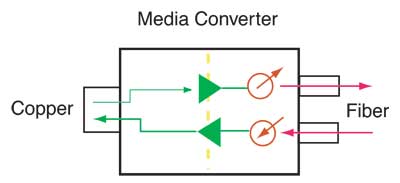 A fiber optic media converter is very similar to a fiber optic transceiver, except it is intended to be used external to connected hardware rather than be built into the equipment. It consists of a interface on one end that matches a standardized interface (e.g. copper 1000base-T or Gigabit Ethernet over Cat 5e), some internal electronics that convert the signals to be compatible with optical fiber and fiber transceivers. Media converters may require outside power sources or may operate from signal power or standard interfaces (Power over Ethernet, USB, etc.)  Media converters are used in pairs, converting from copper to fiber and back to copper again. The fiber compatibility required will determine the type of fiber transmitters used, LEDs for slow multimode systems, VCSELs for faster gigabit multimode systems and lasers for singlemode systems. The conversion electronics will be determined by the interface type. Digital signals in LANs require different conversions than analog CCTV cameras or CATV broadcast systems, for example. Not all media converters convert copper signals to fiber. Some convert multimode to singlemode where the user needs to connect signals over longer distances or only has singlemode fiber available on a link cable run. Some media converters also convert protocols, for example convert analog signals to digital, some may multiplex several signals over one fiber pair, or perform other signal processing.  Another type of media converter (above) has also been developed from the technology used for FTTH PONs (passive optical networks). PON transceivers transmit and receive on the same fiber, sending signals in opposite directions simultaneously at different wavelengths. This can be very convenient since the link only requires one singlemode fiber, not two. Most companies call them bidirectional or BiDi media converters. Since most applications require replacing copper cabling with fiber, the link will include media converters at each end of the link connected with fiber as in the demos below. At either end, the hardware can connect with compatible copper ports and the transmission can be over fiber. 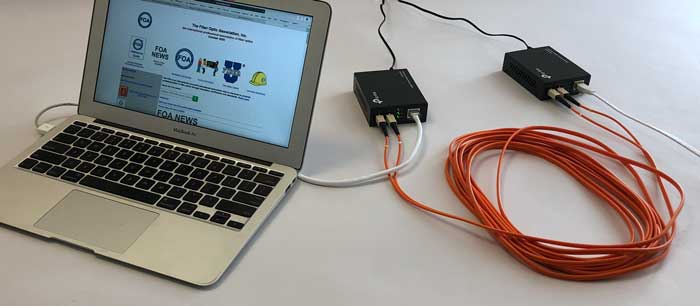 Here is a simple demonstration. A laptop with Ethernet port is connected to a media converter with a Cat 6 cable. The media converter at the far end is connected over multimode fiber. It then connects to an Internet router over copper cables. The demo above uses multimode fiber, but as you can see below, singlemode fiber is equally easy to use and the media converters are practically the same cost as multimode.  Here is a similar demo over singlemode fiber. 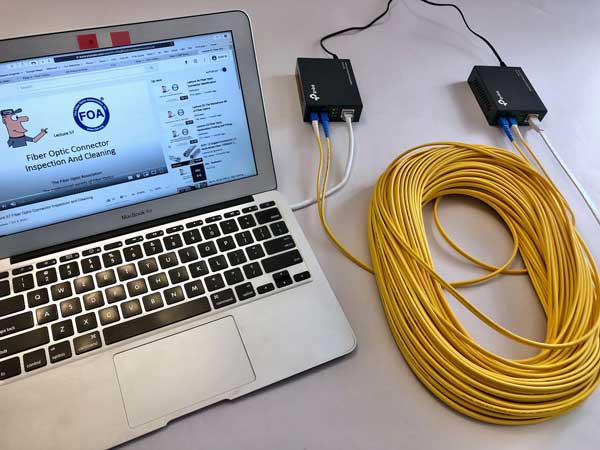 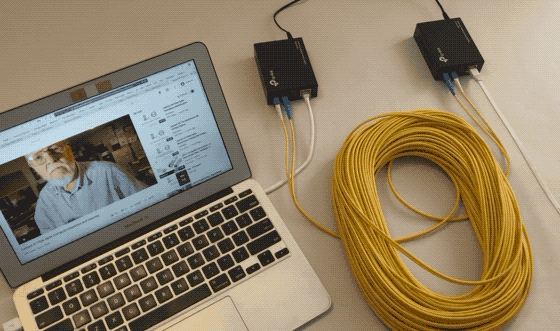 Watching a YouTube video through a media converter-SM fiber link 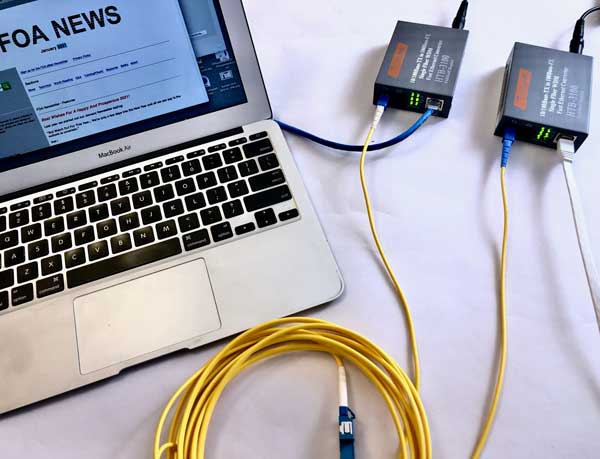 Above is the same demo but using bidirectional media converters on one fiber as described above. Note the media converters are only using one fiber each.  These bidirectional media converters can also be used to show how a PON (passive optical network) works. Connect them through a splitter like those used in FTTH PONs to show how they can transmit through the splitter. Leave the converter on the single input but move the one of the output from port to port to see how it works on any of the output ports. More: FOA video Lecture 58 Fiber Optic Media Conversion on YouTube Fiber U MiniCourse on Media Conversion Table of Contents: The FOA Reference Guide To Fiber Optics |
|
|